Speed Tracking Control of High-Speed Train Based on Particle Swarm Optimization and Adaptive Linear Active Disturbance Rejection Control
Abstract
1. Introduction
- (1)
- In this paper, a multi-mass point HST model with time-varying coefficients is selected as the controlled object, which is more in line with the actual operation;
- (2)
- A control scheme combining IPSO and ALADRC is proposed to solve the problem of HST speed tracking. As the main controller, LADRC can estimate and compensate for the total disturbance of the system in real-time. This enables each carriage with the traction unit to be controlled independently by LADRC to ensure the stability of HSTs during operation;
- (3)
- In order to solve the problem of parameter settings in LADRC, IPSO is proposed to optimize the four key parameters , , , and in LADRC with the goal of minimizing the HST speed tracking error. By this method, LADRC can quickly and accurately obtain better parameter values under the ideal conditions of known route, which greatly simplifies the parameter setting process;
- (4)
- In order to adapt LADRC to the complex and changeable operating environment and to solve the problem of LESO, slight observation errors may be caused due to bandwidth limitations. Thus, APC is introduced. The combination of LADRC and APC can effectively improve the control performance when LADRC encounters unknown disturbances. The stability of the whole system can also be proved by the Lyapunov stability theory. Finally, by comparing with LADRC, it is verified that the designed control has more advantages in HST speed tracking.
2. Dynamic Model of a High-Speed Train
3. Design of the Control Scheme
3.1. Design of the High-Speed Train Speed Control System
3.2. Design of Improved Particle Swarm Optimization
3.3. Design of Adaptive Linear Active Disturbance Rejection Control
3.4. System Stability Analysis
4. Simulation Results and Analysis
4.1. System Stability Analysis
4.2. Controller Parameter Optimization
4.3. High-Speed Train Tracking Control
5. Conclusions
Author Contributions
Funding
Institutional Review Board Statement
Informed Consent Statement
Data Availability Statement
Conflicts of Interest
References
- Yao, X.; Park, J.; Dong, H.; Guo, L.; Lin, X. Robust adaptive nonsingular terminal sliding mode control for automatic train operation. IEEE Trans. Syst. Man Cybern. Syst. 2018, 49, 2406–2415. [Google Scholar] [CrossRef]
- Zhao, C.; Chen, J.; Zhang, X.; Wang, Z.; Wu, P.; Cui, Z. Fluctuating Demand-Oriented Optimization of Train Line Planning Considering Carriage Resources Transfer under Flexible Compositions. Appl. Sci. 2022, 12, 8965. [Google Scholar] [CrossRef]
- Li, Z.; Hou, Z.; Yin, C. Iterative learning control for train trajectory tracking under speed constrains with iteration-varying parameter. Trans. Inst. Meas. Control 2015, 37, 485–493. [Google Scholar] [CrossRef]
- Mikulski, J.; Gorzelak, K. Conception of modernization of a line section example in the context of a fast railway connection. Arch. Transp. 2017, 44, 47–54. [Google Scholar] [CrossRef]
- Chen, X.; Zhang, Y.; Huang, H. Train speed control algorithm based on PID controller and single-neuron PID controller. In Proceedings of the 2010 Second WRI Global Congress on Intelligent Systems, Wuhan, China, 16–17 December 2010; pp. 107–110. [Google Scholar]
- Mo, X.; Tang, T.; Dong, C.; Yao, Y.; Yao, X. A realization and simulation of ATO speed control module-predictive fuzzy control algorithm. In Proceedings of the 2013 IEEE International Conference on Intelligent Rail Transportation Proceedings, Beijing, China, 30 August 2013; pp. 263–267. [Google Scholar]
- Cao, Y.; Ma, L.; Zhang, Y. Application of fuzzy predictive control technology in automatic train operation. Clust. Comput. 2019, 22, 14135–14144. [Google Scholar] [CrossRef]
- Mao, Z.; Yan, X.; Jiang, B.; Chen, M. Adaptive fault-tolerant sliding-mode control for high-speed trains with actuator faults and uncertainties. IEEE Trans. Intell. Transp. Syst. 2020, 21, 2449–2460. [Google Scholar] [CrossRef]
- Li, S.; Yang, L.; Gao, Z. Adaptive coordinated control of multiple high-speed trains with input saturation. Nonlinear Dyn. 2016, 83, 2157–2169. [Google Scholar] [CrossRef]
- He, Z.; Yang, Z.; Lu, J. Braking control algorithm for accurate train stopping based on adaptive fuzzy sliding mode. China Railw. Sci. 2019, 40, 122–129. [Google Scholar]
- Lin, C.; Tsai, S.; Chen, C.; Li, T. Extended sliding-mode controller for high speed train. In Proceedings of the 2010 International Conference on System Science and Engineering, Taipei, Taiwan, 1–3 July 2010; pp. 475–480. [Google Scholar]
- Dong, H.; Gao, S.; Ning, B. Cooperative control synthesis and stability analysis of multiple trains under moving signaling systems. IEEE Trans. Intell. Transp. Syst. 2016, 17, 2730–2738. [Google Scholar] [CrossRef]
- Wang, B.; Yang, J.; Jiao, H.; Zhu, K.; Chen, Y. Design of auto disturbance rejection controller for train traction control system based on artificial bee colony algorithm. Measurement 2020, 160, 107812. [Google Scholar] [CrossRef]
- Kong, X.; Zhang, T. Non-singular fast terminal sliding mode control of high-speed train network system based on improved particle swarm optimization algorithm. Symmetry 2020, 12, 205. [Google Scholar] [CrossRef]
- Hou, T.; Guo, Y.; Ni, H. Research on speed control of high-speed train based on multi-point model. Arch. Transp. 2019, 50, 35–46. [Google Scholar] [CrossRef]
- Chen, Y.; Huang, D.; Huang, T.; Qin, N. Tracking control via iterative learning for high-speed trains with distributed input constraints. IEEE Access 2019, 7, 84591–84601. [Google Scholar] [CrossRef]
- Ji, H.; Hou, Z.; Zhang, R. Adaptive iterative learning control for high-speed trains with unknown speed delays and input saturations. IEEE Trans. Autom. Sci. Eng. 2016, 13, 260–273. [Google Scholar] [CrossRef]
- Han, J. Active disturbance rejection controller and application. Control Decis. 1998, 13, 3–5. [Google Scholar]
- Gao, Z. Scaling and bandwidth-parameterization based controller tuning. Proc. Am. Control Conf. 2006, 6, 4989–4996. [Google Scholar]
- Cheng, M.; Jiao, X. Modified active disturbance rejection control for non-linear semi-active vehicle suspension with magneto-rheological damper. Trans. Inst. Meas. Control 2018, 40, 2611–2621. [Google Scholar] [CrossRef]
- Yu, T.; Chan, K.; Tong, J.; Zhou, B.; Li, D. Coordinated robust nonlinear boiler-turbine-generator control systems via approximate dynamic feedback linearization. J. Process Control 2010, 20, 365–374. [Google Scholar] [CrossRef]
- Pawar, S.; Chile, R.; Patre, B. Modified reduced order observer based linear active disturbance rejection control for TITO systems. ISA Trans. 2017, 71, 480–494. [Google Scholar] [CrossRef]
- Zhou, X.; Zhong, W.; Ma, Y.; Guo, K.; Yin, J.; Wei, C. Control strategy research of D-STATCOM using active disturbance rejection control based on total disturbance error compensation. IEEE Access 2021, 9, 50138–50150. [Google Scholar] [CrossRef]
- Zhao, F.; Wang, X.; Zhu, T. Power Dynamic Decoupling Control of Grid-Forming Converter in Stiff Grid. IEEE Trans. Power Electron. 2022, 37, 9073–9088. [Google Scholar] [CrossRef]
- Liu, C.; Cheng, Y.; Liu, D.; Cao, G.; Lee, I. Research on a LADRC strategy for trajectory tracking control of delta high-speed parallel robots. Math. Probl. Eng. 2020, 2020, 12. [Google Scholar] [CrossRef]
- Hua, L.; Zhang, J.; Li, D.; Xi, X. Fault-Tolerant Active Disturbance Rejection Control of Plant Protection of Unmanned Aerial Vehicles Based on a Spatio-Temporal RBF Neural Network. Appl. Sci. 2021, 11, 4084. [Google Scholar] [CrossRef]
- Guo, B.; Bacha, S.; Alamir, M.; Mohamed, A.; Boudinet, C. LADRC applied to variable speed micro-hydro plants: Experimental validation. Control Eng. Pract. 2019, 85, 290–298. [Google Scholar] [CrossRef]
- Zhou, Y.; Luo, D.; Wu, B.; Cheng, B.; Lin, Q. Active vibration isolation system based on the LADRC algorithm for atom interferometry. Appl. Opt. 2020, 59, 3487–3493. [Google Scholar] [CrossRef] [PubMed]
- Geng, X.; Zhu, Q.; Liu, T.; Na, J. U-model based predictive control for nonlinear processes with input delay. J. Process Control 2019, 75, 156–170. [Google Scholar] [CrossRef]
- Wang, H.; Huang, H. Property and applications of extended state observer. Control Decis. 2013, 28, 1078–1082. [Google Scholar]
- Liu, Y.; Zhou, Y.; Sun, S.; Xun, J.; Tang, T. An analytical optimal control approach for virtually coupled. Transp. Res. Part C Emerg. Technol. 2020, 125, 102886. [Google Scholar] [CrossRef]
- Arnold, M.; Burgermeister, B.; Fuhrer, C.; Hippmann, G.; Rill, G. Numerical methods in vehicle system dynamics: State of the art and current developments. Veh. Syst. Dyn. 2011, 49, 1159–1207. [Google Scholar] [CrossRef]
- Chen, B.; Huang, Z.; Zhang, R.; Jiang, F.; Liu, W.; Li, H.; Peng, J. Adaptive slip ratio estimation for active braking control of high-speed trains. ISA Trans. 2021, 112, 302–314. [Google Scholar] [CrossRef]
- Chu, H.; Yi, J.; Yang, F. Chaos Particle Swarm Optimization Enhancement Algorithm for UAV Safe Path Planning. Appl. Sci. 2022, 12, 8977. [Google Scholar] [CrossRef]
- Wu, L.; Han, J. Active disturbance rejection controller scheme for the linear inverted pendulum. Control Theory Appl. 2004, 21, 665–670. [Google Scholar]
- Mou, J.; Zhang, W.; Wu, C.; Guo, Q. Adaptive Control of Flapping-Wing Micro Aerial Vehicle with Coupled Dynamics and Unknown Model Parameters. Appl. Sci. 2022, 12, 9104. [Google Scholar] [CrossRef]
- Tang, H.; Wang, Q.; Feng, X. Robust stochastic control for high-speed trains with nonlinearity, parametric uncertainty, and multiple time-varying delays. IEEE Trans. Intell. Transp. Syst. 2018, 19, 1027–1037. [Google Scholar] [CrossRef]

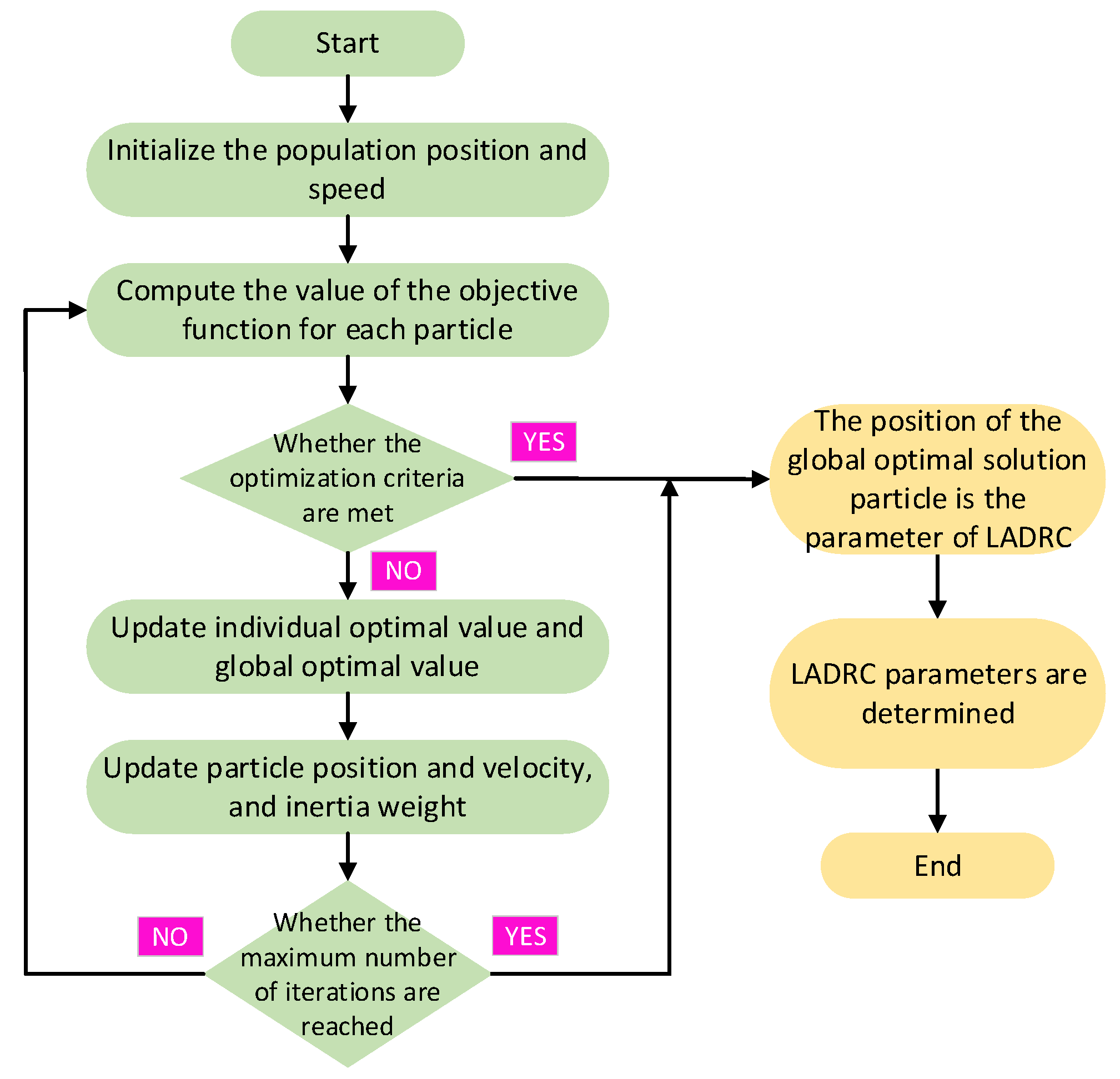

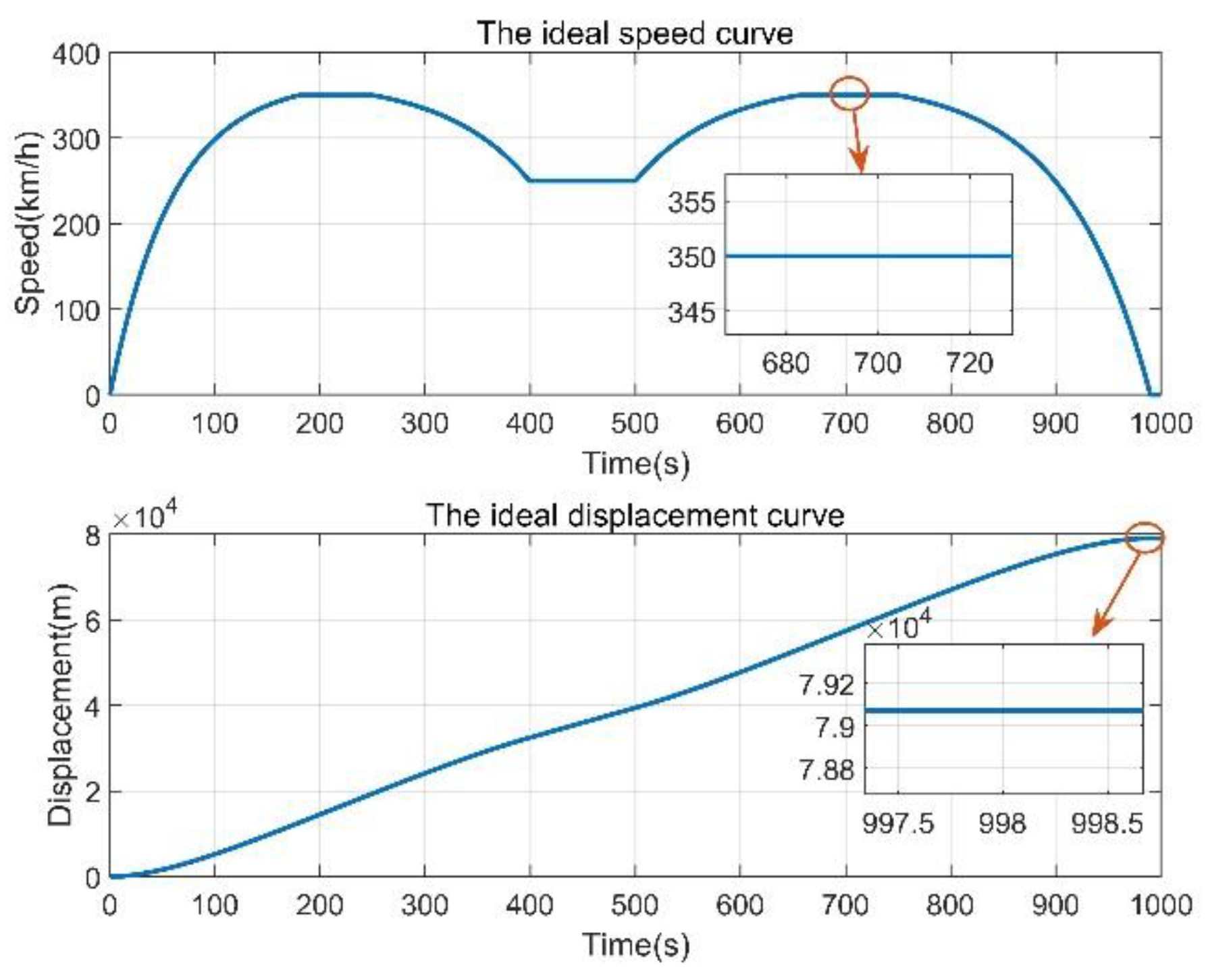
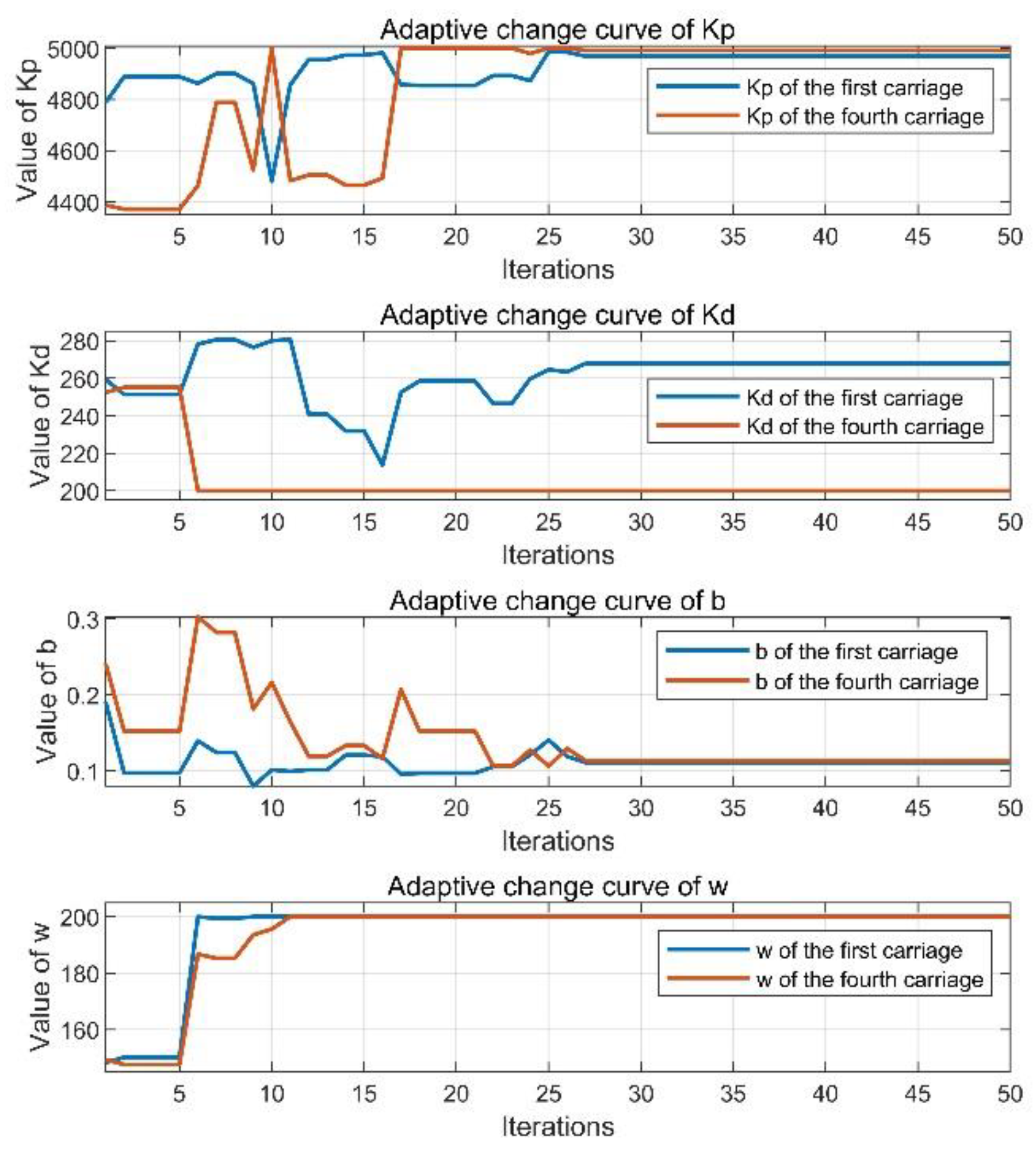
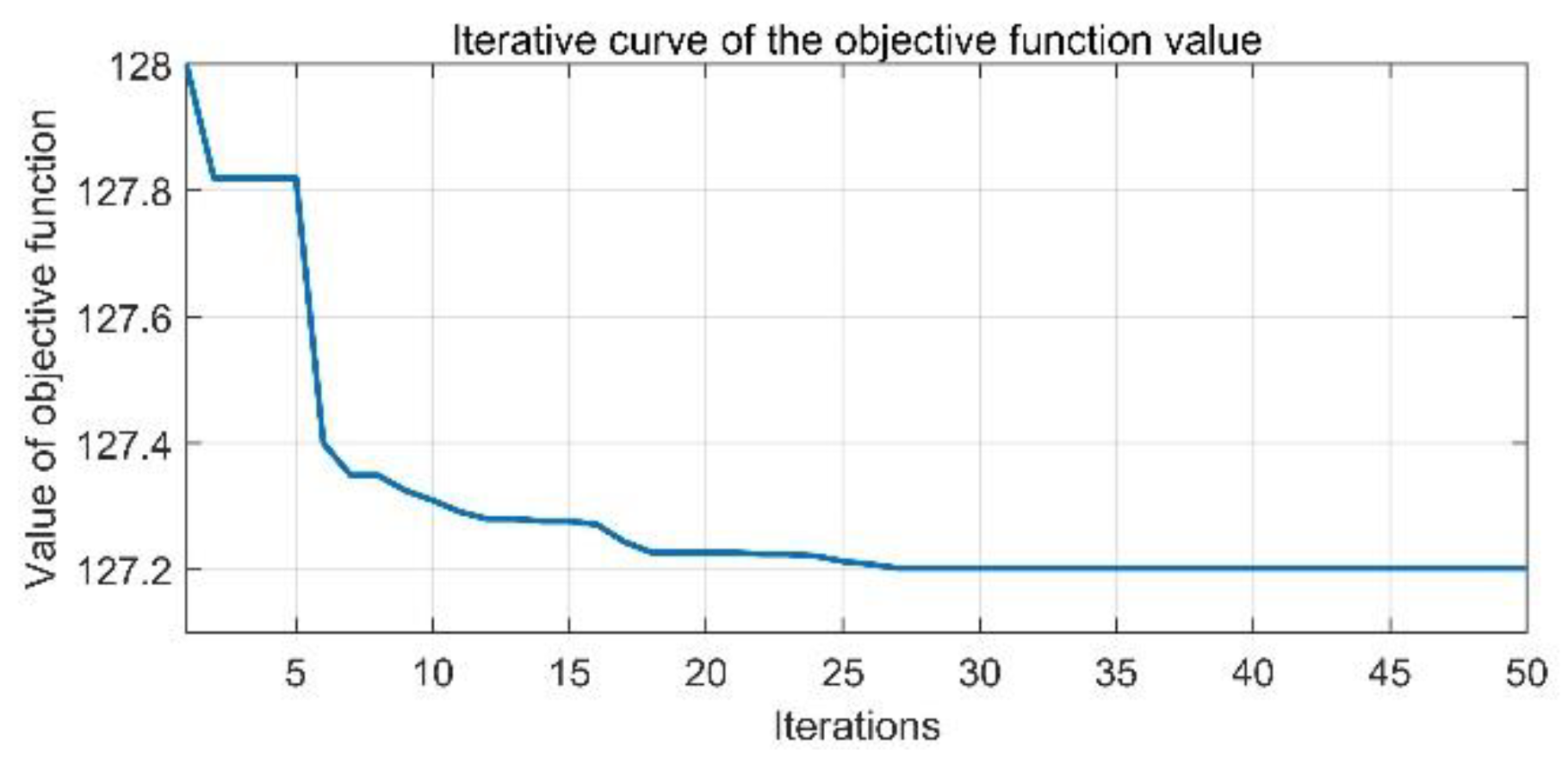
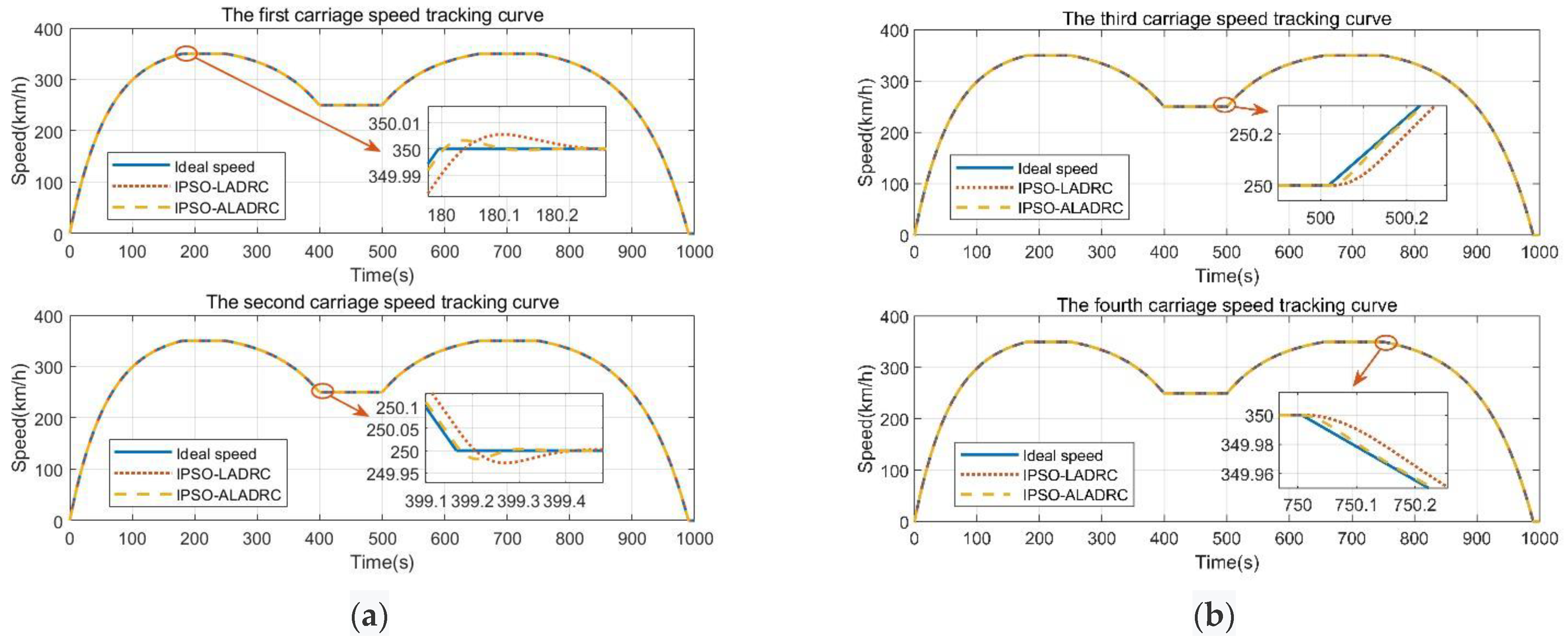

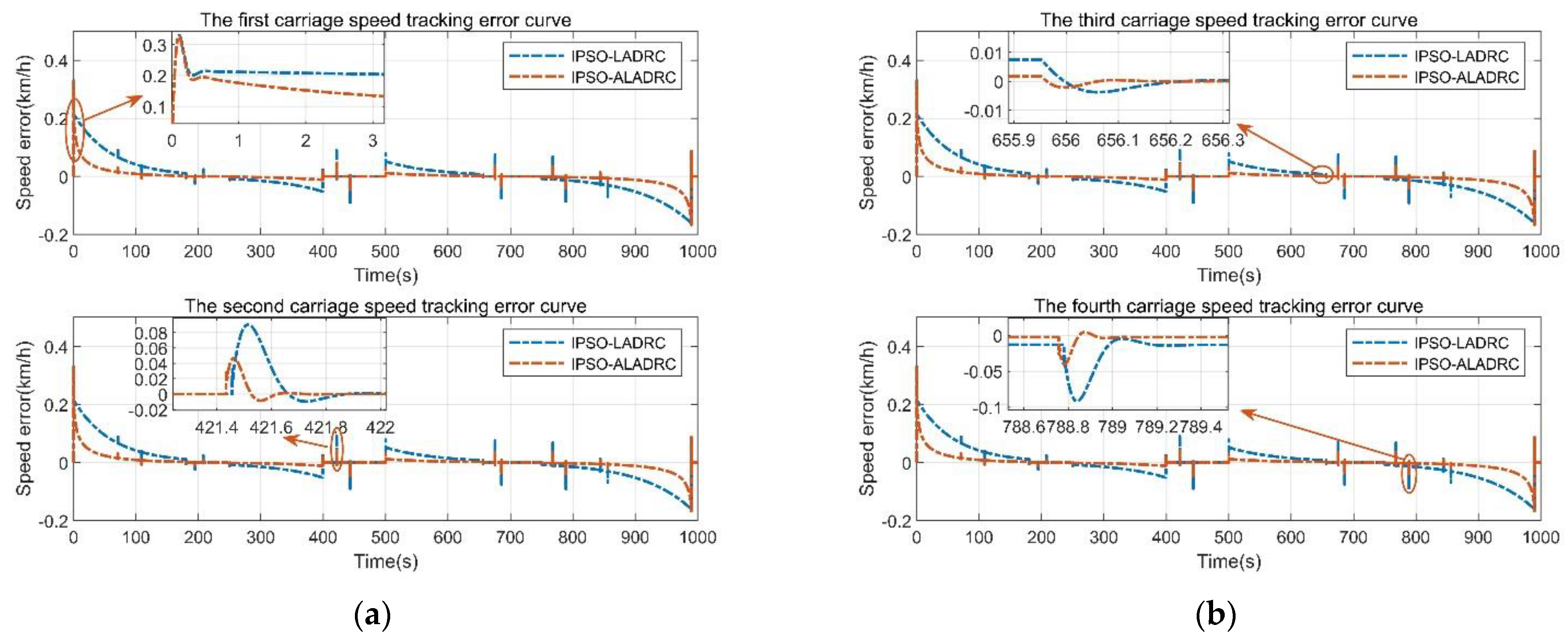
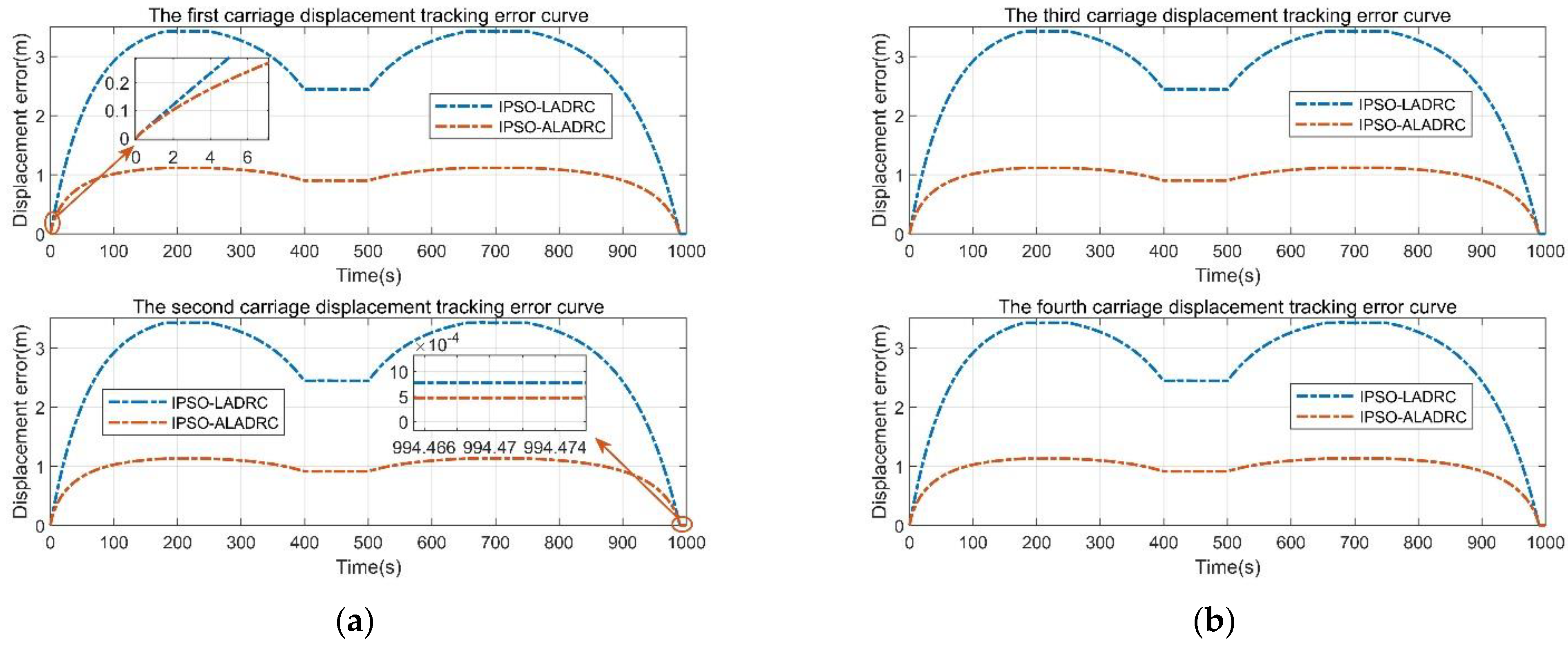


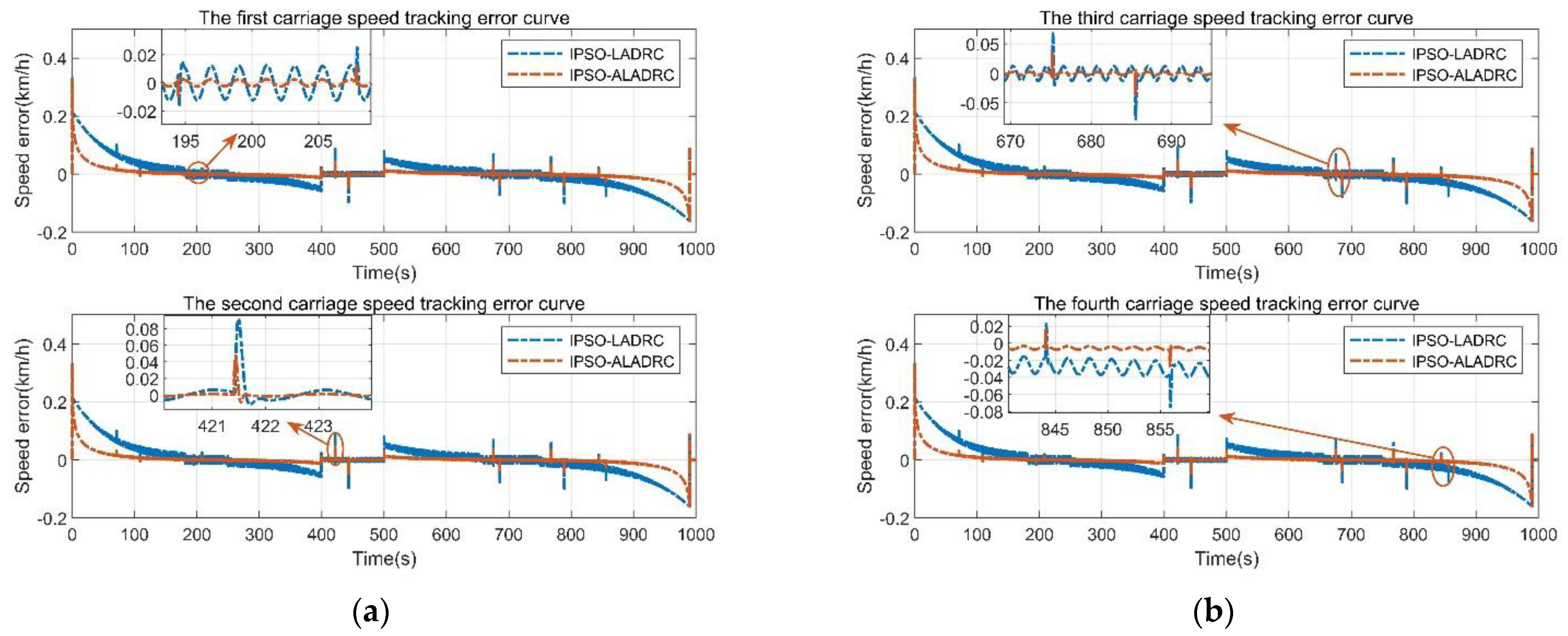
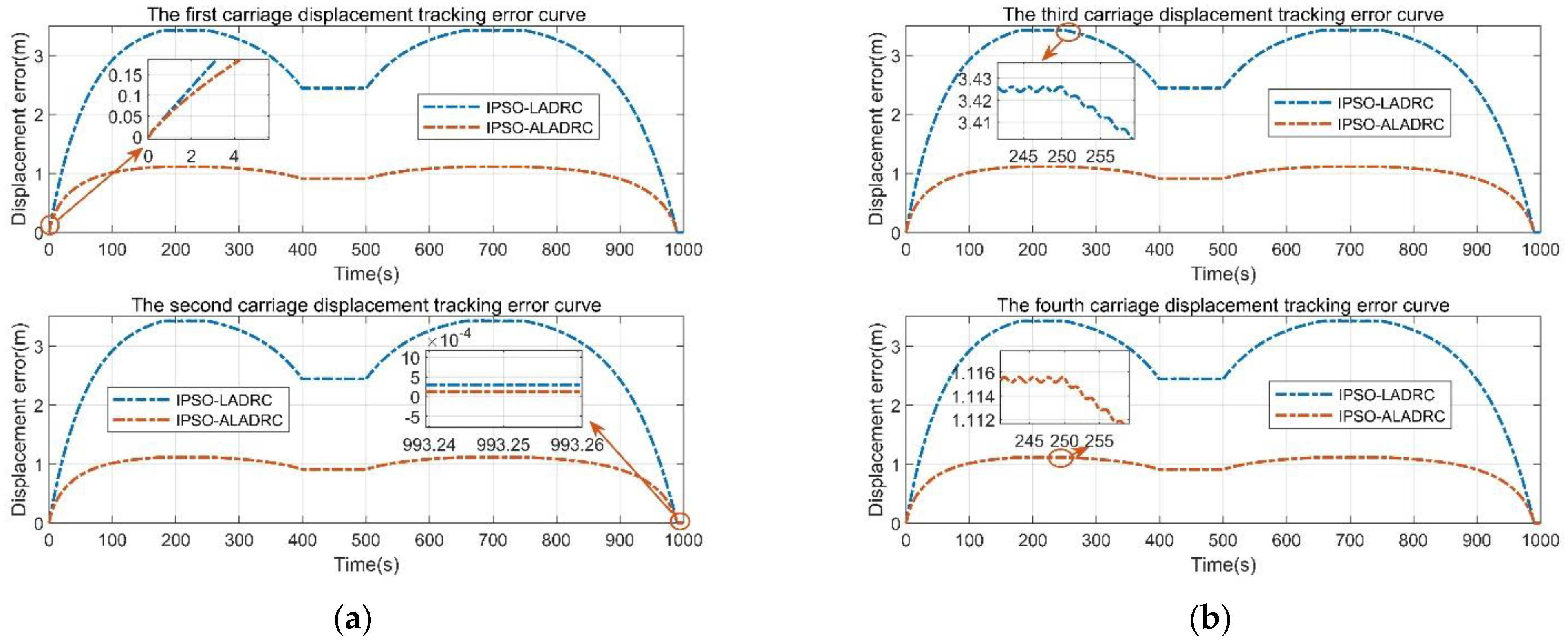
| Road Condition | Parameter Setting | ||
|---|---|---|---|
| Ramp | |||
| Curve | |||
| Tunnel | |||
| Parameters | Value |
|---|---|
| Parameters | ||||
|---|---|---|---|---|
| First carriage | ||||
| Fourth carriage |
Publisher’s Note: MDPI stays neutral with regard to jurisdictional claims in published maps and institutional affiliations. |
© 2022 by the authors. Licensee MDPI, Basel, Switzerland. This article is an open access article distributed under the terms and conditions of the Creative Commons Attribution (CC BY) license (https://creativecommons.org/licenses/by/4.0/).
Share and Cite
Xue, J.; Zhuang, K.; Zhao, T.; Zhang, M.; Qiao, Z.; Cui, S.; Gao, Y. Speed Tracking Control of High-Speed Train Based on Particle Swarm Optimization and Adaptive Linear Active Disturbance Rejection Control. Appl. Sci. 2022, 12, 10558. https://doi.org/10.3390/app122010558
Xue J, Zhuang K, Zhao T, Zhang M, Qiao Z, Cui S, Gao Y. Speed Tracking Control of High-Speed Train Based on Particle Swarm Optimization and Adaptive Linear Active Disturbance Rejection Control. Applied Sciences. 2022; 12(20):10558. https://doi.org/10.3390/app122010558
Chicago/Turabian StyleXue, Jingze, Keyu Zhuang, Tong Zhao, Miao Zhang, Zheng Qiao, Shuai Cui, and Yunlong Gao. 2022. "Speed Tracking Control of High-Speed Train Based on Particle Swarm Optimization and Adaptive Linear Active Disturbance Rejection Control" Applied Sciences 12, no. 20: 10558. https://doi.org/10.3390/app122010558
APA StyleXue, J., Zhuang, K., Zhao, T., Zhang, M., Qiao, Z., Cui, S., & Gao, Y. (2022). Speed Tracking Control of High-Speed Train Based on Particle Swarm Optimization and Adaptive Linear Active Disturbance Rejection Control. Applied Sciences, 12(20), 10558. https://doi.org/10.3390/app122010558





